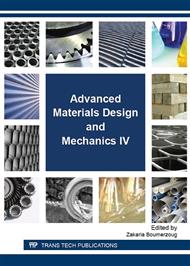[1]
R.E. Giudici, A.H. Hoveyda. Directed catalytic asymmetric olefin metathesis. Selectivity control by enoate and ynoate groups in Ru-catalyzed asymmetric ring-opening/ cross-metathesis, J. Journal of the American Chemical Society. 129(2007).
DOI: 10.1021/ja070187v.s002
Google Scholar
[2]
T. Ritter, M.W. Day, R.H. Grubbs. Rate acceleration in olefin metathesis through a fluorine-ruthenium interaction, J. Journal of the American Chemical Society. 128(2006) 11768-11769.
DOI: 10.1021/ja064091x
Google Scholar
[3]
K. Arentsen, S. Caddick, F.G.N. Cloke. On the efficiency of two-coordinate palladium (0) N-heterocyclic carbene complexes in amination and Suzuki–Miyaura reactions of aryl chlorides, J. Tetrahedron. 61(2005) 9710-9715.
DOI: 10.1016/j.tet.2005.06.070
Google Scholar
[4]
W.A. Herrmann, V.P.W. Böhm, C.W.K. Gstöttmayr. Synthesis, structure and catalytic application of palladium (II) complexes bearing N-heterocyclic carbenes and phosphines, J. Journal of Organometallic Chemistry. 617 (2001) 616-628.
DOI: 10.1016/s0022-328x(00)00722-1
Google Scholar
[5]
I.J.B. Lin, C.S. Vasam. Preparation and application of N-heterocyclic carbene complexes of Ag (I), J. Coordination chemistry reviews. 251(2007) 642-670.
DOI: 10.1016/j.ccr.2006.09.004
Google Scholar
[6]
X. Zhang, S. Gu, Q. Xia, et al. New structural motifs of silver and gold complexes of pyridine-functionalized benzimidazolylidene ligands, J. Journal of Organometallic Chemistry. 694(2009) 2359-2367.
DOI: 10.1016/j.jorganchem.2009.03.031
Google Scholar
[7]
B. Liu, W. Chen, S. Jin. Synthesis, Structural Characterization, and Luminescence of New Silver Aggregates Containing Short Ag-Ag Contacts Stabilized by Functionalized Bis (N-heterocyclic carbene) Ligands, J. Organometallics. 26(2007) 3660-3667.
DOI: 10.1021/om0701928
Google Scholar
[8]
M. Tenne, S. Metz, I. Münster, et al. Phosphorescent Platinum (II) Complexes Based on C∧ C* Cyclometalating Aryltriazol-5-ylidenes, J. Organometallics. 32(2013) 6257-6264.
DOI: 10.1021/om4004576
Google Scholar
[9]
V.A. Krylova, P.I. Djurovich, M.T. Whited. Synthesis and characterization of phosphorescent three-coordinate Cu (i)–NHC complexes, J. Chemical Communications. 46(2010) 6696-6698.
DOI: 10.1039/c0cc01864c
Google Scholar
[10]
M.J. Leitl, V.A. Krylova, P.I. Djurovich, et al. Phosphorescence versus Thermally Activated Delayed Fluorescence. Controlling Singlet–Triplet Splitting in Brightly Emitting and Sublimable Cu (I) Compounds, J. Journal of the American Chemical Society. 136(2014).
DOI: 10.1021/ja508155x
Google Scholar


